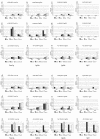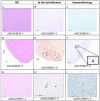Both viral and host factors contribute to neurovirulence of bovine herpesviruses 1 and 5 in interferon receptor-deficient mice
- PMID: 15016885
- PMCID: PMC371052
- DOI: 10.1128/jvi.78.7.3644-3653.2004
Both viral and host factors contribute to neurovirulence of bovine herpesviruses 1 and 5 in interferon receptor-deficient mice
Abstract
Herpes simplex virus (HSV) type 1 and bovine herpesviruses 1 and 5 (BHV-1 and BHV-5) can use the same cellular receptor for entry, but only HSV is known to cause disease in mice. We hypothesized that components of either the innate or the adaptive immune system, or a combination of both, were responsible for curbing replication of BHVs in mice. Therefore, wild-type mice as well as mice with various combined genetic deficiencies in the alpha/beta interferon receptor or gamma interferon receptor and in the ability to produce mature B and T lymphocytes (RAG-2 deletion) were infected with BHV-1 and BHV-5 and monitored clinically, serologically, histopathologically, and virologically. A functional immune system protected the mice from disease and death due to BHV infection, and the immune response was Th1 like. BHV-5 was transported to the central nervous system by the axonal pathway, whereas viremia was required for this outcome with BHV-1. The alpha/beta interferon system was able to obstruct quantitative spread of the viruses in the infected organism. The gamma interferon system had a protective effect against BHV-1, even in mice with the RAG-2 deletion. In contrast, the same mice succumbed to neurological disease and death upon infection with BHV-5. Productively infected neurons were detected only in BHV-5-infected mice with an intact gamma interferon system. We conclude that the alpha/beta interferon system had a protective effect, while an intact gamma interferon system was required for efficient replication of BHV-5 in mouse neurons and for the development of neurological disease.
Figures




References
-
- Abu-Shakra, M., and Y. Shoenfeld. 1991. Chronic infections and autoimmunity. Immunol. Ser. 55:285-313. - PubMed
-
- Ashkar, A. A., G. P. Black, Q. Wei, H. He, L. Liang, J. R. Head, and B. A. Croy. 2003. Assessment of requirements for IL-15 and IFN regulatory factors in uterine NK cell differentiation and function during pregnancy. J. Immunol. 171:2937-2944. - PubMed
-
- Bagust, T. J., and L. Clark. 1972. Pathogenesis of meningo-encephalitis produced in calves by infectious bovine rhinotracheitis herpesvirus. J. Comp. Pathol. 82:375-383. - PubMed
-
- Barenfus, M., C. A. Delliquadri, R. W. McIntyre, and R. J. Schroeder. 1963. Isolation of infectious bovine rhinotracheitis virus from calves with meningo-encephalitis. J. Am. Vet. Med. Assoc. 143:725-728. - PubMed
Publication types
MeSH terms
Substances
LinkOut - more resources
Full Text Sources
Other Literature Sources
Molecular Biology Databases

